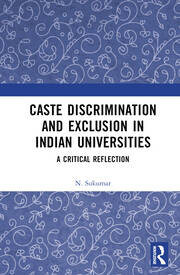How Does Caste Operate in Indian Higher Education?
In his introduction to Caste in Indian Politics, Rajni Kothari emphasises the stability of the caste system vis-à-vis a modernising society. Caste privilege, he argues, is deeply mutative.

Caste Discrimination and Exclusion in Indian Universities"
A Critical Reflection by N. Sukumar. Photo: Routledge.
N. Sukumar argues something similar in the context of higher education in Caste Discrimination and Exclusion in Indian Universities: A Critical Reflection. The 2022 book shows how caste endures even in progressive spaces. Sukumar locates caste discrimination in multiple spaces, including in classrooms, hostels, and cultural forums by interviewing 600 Scheduled Caste (SC) students from select central and state universities.
The initial chapters foreground the social embeddedness of the education system, which means the understanding that academia does not exist in a vacuum, but operates in a network of interactions among caste, gender, class, and language. The fourth chapter presents 16 narratives of Dalit students in higher education. This is a heterogeneous sample including both first generation learners from working class backgrounds and elite Dalits. Together they paint a powerful story of alienation, and oppression produced by caste.
In the penultimate chapter, Sukumar delves into the darkest consequence of caste discrimination in educational institutions: deaths by suicides, and stresses their social nature. The concluding chapter goes over recent policy changes and the rusting legal remedies in place.
Also read: Subtly But Surely, India's Premier Colleges Still Enforce Caste Norms. I Saw it First Hand.
This is not the first time Sukumar has written about caste discrimination in education. His earlier auto-ethnographic work focused on the life worlds of SC students at the Hyderabad University. He has been a faculty of Delhi University’s political science department for over two decades now. Despite this, he notes that he is often only considered an SC/ST observer. The author’s social and disciplinary location are both relevant to the book, but neither solely make up his voice. He uses both quantitative and qualitative data, and the scholarship he cites cuts across disciplines.
Imperceptible but everyday casteism
Through the course of the book, Sukumar repeatedly argues that caste discrimination manifests in multiple forms. To begin with, he points toward the humiliating “jokes”, noting how many “Dalit girls in Delhi have spoken about how they have been ridiculed by the question 'Quote se aye ho ya kothe se (Have you come via reservation quota or brothel?)'".
Sukumar argues that in educational spaces, caste privilege is transformed into a language of “merit”. Students who enter educational institutions through reservations are immediately marked as non-meritorious. Faculty members often drill students about their admission test ranks to single out the SC/ST/OBC students. Imagine the Janeu, but in the form of a list. An invisible line separating the “meritorious and the casteless” and Dalits.

A classroom. Photo: Pixabay
The book also discusses how university faculty and staff inhibit Dalit students from availing scholarships or securing a passing mark; instances of sexual harassment against women Dalit students, and cases where Dalit students were made to clean toilets. There are several more imperceptible ways caste operates: the trains of gossip that follow Dalit students, the lack of cultural and social opportunities, and the absence of role models and mentorship. Viewing discrimination as a spectrum helps widen the net of complicity to include even those who may believe themselves progressive. Thus, the individual intention could be irrelevant to caste discrimination.
The defocus on the individual allows us to look at caste discrimination not as one person’s – the “outlier evil Savarna”– ill-treatment of another, but as produced by a socially embedded institution that is inherently discriminatory. By constructing this nuanced claim, Sukumar shows us that discrimination survives because it does not solely rely on the evil of individuals, but because it is immanent in India’s higher education system. But how do we go from caste discrimination as a spectrum to its institutionalisation? The book does not adequately explain this. Perhaps, the jokes, comments, and gestures have gained legitimacy in a shared spatiality of upper caste-ness. A dispersed Agragarah.
Also read: Dalit Student's Suicide Points to Well-Known – But Ignored – Caste Discrimination in IITs
The institution is bent against the Dalit student. Sukumar’s book provides evidence in the form of poor faculty recruitment, inadequate implementation of reservation, and slashing of scholarships. The author also cites an extensive Right to Information (RTI) study that shows that SC/ST cells are frequently non-existent. Where they do exist, they are heavily reliant on the efficiency and altruism of the appointed faculty.
This is also the case with curriculum changes. Caste-aware faculty (who frequently happen to be Dalits themselves) are enthusiastic about sensitising students about caste. Dalit teachers too are discriminated and ghettoised into certain roles. They take care of awareness campaigns, SC/ST cells, conversations between faculty and students, and the protests of sanitation workers. This unsustainable dependence on individual conscience often wears out, and the Dalit students are left with nothing but their own equally fragile coping mechanisms.
Sukumar writes that for many Dalit students, the easiest mode of survival is to be invisible and attempt to lead a ‘normal’ life. However, he adds, many unable to cope with the oppressive system, either drop out or die by suicide.
Reservations may provide access to higher education, but as the many deaths by suicides of Dalit students reflect, the battle for creating truly nourishing educational spaces is a much longer one. If we are to address caste discrimination which is heterogenous and institutional, there is a need to examine remedies that can attend to the whole spectrum. Even more, there is an urgent requirement for a politics that is radical yet empathetic.
This is Sukumar’s simple yet noble claim, one that bears repeating. This book is a huge contribution to the field of education, provided it does not simply get shelved under ‘caste studies’. The annihilation of caste and the creation of safe educational institutions benefit not only Dalit students but everyone.
Barathi Nakkeeran is a researcher based in Delhi. Her reviews have appeared in The Hindu, the Chicago Review of Books, and the LSE Review of Books. She has also published with the Economic and Political Weekly and the Down to Earth. She works on issues of waste, labour, caste, and urbanism.
This article went live on March twenty-second, two thousand twenty three, at eighteen minutes past four in the afternoon.The Wire is now on WhatsApp. Follow our channel for sharp analysis and opinions on the latest developments.




